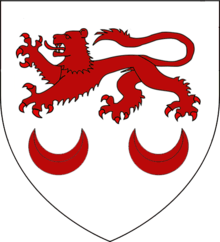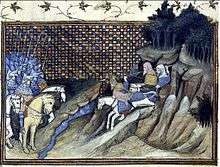Caomhánach
| Caomhánach | |
|---|---|
 | |
| Country | Ireland |
| Parent house | Uí Ceinnselaig of Laigin |
| Titles | King of Leinster |
| Founder |
Domhnall Caomhánach King of Leinster (1171–1175) |
| Final ruler |
Domhnall Spainneach King of Leinster (1595–1632) |
| Current head |
Cathal Cavanagh Inaugurated 12 September 2012 |
Caomhánach (IPA: [kɯː'vaːnəx], Caoṁānaċ in traditional Gaelic type[1]) is an Irish language surname first assumed by Domhnall Caomhánach, eldest son of the 12th century Diarmait Mac Murchada, king of Leinster (now Leinster, Ireland).[2] A considerable number of anglicised variations of Caomhánach exist; some of the most common are Kavanagh, Cavanagh, Kavanaugh and Cavanaugh.
Early History - Kings of Leinster
The Caomhánach family is a branch of the Mac Murchada dynasty which descended from Domhnall Caomhánach, eldest son of Diarmait, king of Leinster.
The historic stronghold of the family was known as Uí Ceinnselaig, and included nearly all of County Carlow and County Wexford, with parts of Counties Wicklow and Kilkenny included. The Caomhánach family maintained control of the kingship of Leinster up until the 17th century. This claim was at times disputed and resulted in nearly consistent clashes with Anglo-Norman settlers in Ireland. The lion passant on the Caomhánach arms is a classic heraldic device associated with feudal power but unusual for a family of Gaelic extraction; it may be that it is intended to signify the centuries-long connection of the family with the kingship of Leinster.
12th Century - Origin and Meaning of Name
It is referenced in a translation of the historical Annals of the Four Masters by John O'Donovan that Domhnall Caomhánach was fostered for his training and education at the monastery of Saint Cóemgen at Kilcavan in the Barony of Gorey, County Wexford.[3] According to Irish custom, it was because of this that Domhnall assumed the name Caomhánach in the form of an descriptive byname meaning "a student or follower of Cóemgen".[4] Contrary to usual Irish practice, the name was adopted by his descendants as an inherited surname.[5] In several Gaelic dictionaries, Caomhánach is also defined as "a friend, companion" and "merciful".[6][7]
14th Century - Art Mór mac Murchadha Caomhánach

Art Mór Mac Murchadha Caomhánach is generally regarded as the most formidable of the later Kings of Leinster. Throughout the course of his reign, Art managed to reclaim control over much of the Kingdom of Leinster. He drove the descendants of the Anglo-Norman settlers out of north Wexford and coastal Wicklow and threatened the Anglo-Irish towns of Wexford, Carlow and Dublin. The territory of the Caomhánachs at this period was huge and became known as "the Caomhánach's country" and with good reason: Art held complete control over it, reigning for forty-two years, and even receiving dues from the English crown, the "black rent" as it was known.
Art became such a threat to the English interest in Ireland that Richard II of England made two expeditions to Ireland to bring him into submission, the latter ultimately costing Richard II his throne as he was captured and murdered upon his return to England. Art remained at large as king of Leinster until 1416 or 1417, when he was poisoned in New Ross. Although Domhnall Caomhánach was the first bearer of the name, in fact the majority of the septs that proliferated from the fifteenth century on descend from Art.
17th Century - Nine Years' War
In the 16th century, Cahir mac Art Kavanagh took part in the Desmond Rebellions. Art Kavanagh, a companion of Hugh O'Neill's took part in the dramatic escape from Dublin Castle in 1590. The chiefs of the family continued to take the ruling title mac Murchadha, but by the mid-sixteenth century their power was on the wane, and was decisively broken by the start of the seventeenth century. The last king of Leinster was Domhnall Spainneach Mac Murrough Caomhanach, who finally submitted at the end of the Nine Years' War in 1603.
Despite the family's loss of power and property, the line of descent from the last duly inaugurated Chief of the Name, Brian Kavanagh, The Mac Murchadha, remained unbroken down to recent times. It is not surprising, then, that Caomhánachs were prominent among the great wave of native Irish aristocrats emigrating to Europe in the wake of the final defeat of Gaelic Ireland at the end of the seventeenth century, becoming officers in the armies of Catholic France, Spain and Austria.
In the 17th century Brian Kavanagh fought for the House of Stuart in Scotland and was described as the tallest man in King James' army. Charles Kavanagh rose to be the military Governor of Prague in 1766. Several Caomhánachs were officers in the Irish Brigade in the Jacobin army of France and a branch of the family settled in that country. Caomhánachs also rose to high rank in the empire of Austria-Hungary.[8]
Clann Caomhánach
Clann Caomhánach is registered with the Clans of Ireland, the Irish Government agency set up to co-ordinate the activities of all Irish Clans.[9]
Variations of Name
Clann Chaomhánach covers the following known variations of the family name: Kavanagh, Kavanaugh, Kavanah, Kavenah, Kabana, Kavaner, Kavenaugh, Kavanacht, Kaveny, Cavanagh, Cavanaugh, Cavanah, Cavenah, Kavana, Cavana, Cavner, Cavenaugh, Cavender, Cavenogh, Cavnar, Cavignac, Cavanaogh, Cavanogh, Cabanah, Chaomhanach and many others...[1][9]
See also
References
- 1 2 James J. Kavanagh – Clann Genealogist. "Interpreting the Irish Name "Caomhánach"". Retrieved 4 March 2013.
- ↑ Irish Pedigrees: Or, The Origin and Stem of the Irish Nation by John O'Hart – Published 1892, Volume 1, Page 493
- ↑ Annals of Ireland, by the Four Masters by John O'Donovan - Volume 3 – Page 20 – Footnote "F".
- ↑ Royal House of Leinster. "Origin of the Name Caomhánach". Retrieved 19 December 2007.
- ↑ Sloinnte Gaedheal is Gall: Irish Names and Surnames by Rev. Patrick Woulfe (1923)
- ↑ A Dictionary of the Gaelic Language: In Two Parts by Norman Macleod (1831) – Page 118
- ↑ Dictionarium Scoto-Celticum: a dictionary of the Gaelic language (1828) – Volume 1 – Page 190
- ↑ http://www.irishtimes.com/ancestor/surname/index.cfm?fuseaction=History&Surname=Kavanagh&UserID=
- 1 2 Clann Chaomhánach. "What is Clann Chaomhánach". Retrieved 19 December 2007.
External links
- Clan Caomhánach
- Coláiste Chaomhánach
- Ireland's Wars, How Art MacMurragh Brought Down The English Monarchy at Never Felt Better